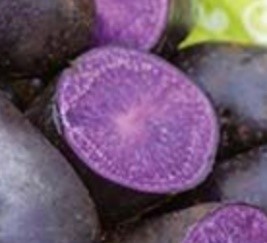Magic Molly fact Sheet

| Magic Molly (Fingerling) |
 |
Parentage – True seed planting from Red Beauty1
Breeder – Discovered by Bill Campbell, a Potato Disease Control Specialist with the state of Alaska and was named after his daughter1; released in 2007 by Campbell and the Alaska DNR Division of Agriculture2
Maturity – Mid-late season2
Usage – Specialty tablestock2; good for roasting, baking, boiling or for home fries; high in phytonutrients, anthocyanins and other antioxidants
Plant – Semi-upright, medium size with a dense canopy; stems are predominantly green but can be purple or mottled/stippled with purple; very fibrous root system2
Leaves – Dull gray-green leaves, some centralized portions of lateral pairs and petioles may be purple2
Flowers – White corolla with orange yellow anthers; medium flowering profusion and berry production2
Tubers – Oblong to long, slightly netted , and slightly waxy tubers with dark purple skin and darker purple flesh; high yield; specific gravity of 1.079; short dormancy and medium, well-distributed eyes
Strengths – Gaining recognition in specialty markets such as organic and market gardening; resistant to hollow heart; its striking purple color does not fade during boiling2; some field resistance to late blight; color doesn’t fade when boiled
Weaknesses –Susceptible to golden nematode, common scab and potato virus X2; made be low yielding in select growing environments2
 Pictures1, 4, 5
Pictures1, 4, 5
References: 1https://www.mainepotatolady.com/productcart/pc/viewCategories.asp?idCategory=134, 2https://www.fedcoseeds.com/moose/magic-molly-fingerling-potato-7625, 3https://www.burpee.com/vegetables/potatoes/potato-magic-molly–prod500396.html, 4https://www.tuckertaters.com/p_d_magic_molly.html, 5https://www.tuckertaters.com/Quick%20Guide%20to%20TFI%20Potato%20Varieties%202018%20Consumers.pdf 5 Justin Bula- Northern Sand Farms
Page 1 of 1
Last Revised: 8/24/22
© 2019 The Board of Regents of the University of Wisconsin System
This article was posted in Fact Sheet.